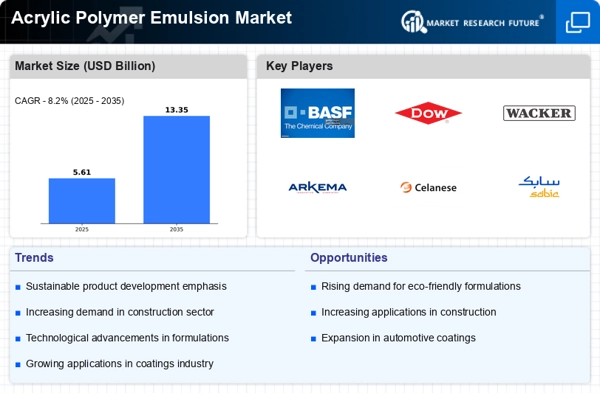Top Industry Leaders in the Acrylic Polymer Emulsion Market
 The acrylic polymer emulsion market thrives on a dynamic stage, teeming with established giants and nimble newcomers vying for a share of the pie. who are the key players driving this growth, and what strategies are they employing to navigate the ever-evolving landscape.
The acrylic polymer emulsion market thrives on a dynamic stage, teeming with established giants and nimble newcomers vying for a share of the pie. who are the key players driving this growth, and what strategies are they employing to navigate the ever-evolving landscape.
Strategies Adopted by Key Players:
-
Product Innovation: Key players are investing heavily in research and development to develop new and improved acrylic polymer emulsions with enhanced properties such as higher durability, better water resistance, and lower VOC emissions. For example, BASF launched its Acronal® PLUS series of high-performance acrylic polymer emulsions for the adhesives and coatings industry. -
Expansion: Leading players are expanding their production capacities and geographical reach through mergers and acquisitions, as well as by setting up new manufacturing facilities in emerging markets. For instance, Dow Chemical acquired Rohm & Haas in 2009, which significantly expanded its acrylic polymer emulsion business. -
Sustainability: Companies are increasingly focusing on developing sustainable acrylic polymer emulsions made from bio-based raw materials or with lower environmental footprints. For example, Arkema launched its Ecoresponsive™ line of bio-based acrylic polymer emulsions. -
Partnerships: Key players are forming strategic partnerships with other companies in the value chain to share resources and expertise. For example, Evonik Industries partnered with DSM to develop new acrylic polymer emulsions for the textile industry.
Factors Influencing Market Share
-
Technological advancements: Developing emulsions with improved performance, sustainability, and application suitability holds immense weight. -
Production cost optimization: Streamlining processes and sourcing raw materials efficiently becomes crucial in a competitive market. -
Distribution network strength: Reaching customers effectively and efficiently determines market access and penetration. -
Regulatory compliance: Adapting to evolving environmental and safety regulations remains essential. -
Brand reputation and customer service: Building trust and loyalty through consistent quality and value-added services fosters brand preference.
Key Players
- Pixi Chem Private Limited (India)
- The Lubrizol Corporation (U.S)
- Kamsons Chemicals Pvt. Ltd (India)
- The Dow Chemical Company (U.S.U.S.)
- Xyntra Chemicals B.V.B.V. (the Netherlands)
- Celanese Corporation (U.S.U.S.)
- StanChem, Inc. (U.S.U.S.)
- Asian Paints Ltd. (India)
Recent News :
April 2020: Synthomer plc, a leading provider of specialty polymer solutions, recently acquired Omnova Solutions Inc., a prominent specialty chemical company known for its expertise in water-based polymer solutions. This strategic move has enabled Synthomer to reinforce its position in the polymer emulsion business and enhance its operational capabilities on a scale.
May 2017: The Dow Chemical Company has recently entered into two agreements to drive its strategic innovation agenda in Saudi Arabia. As part of these agreements, the company plans to build an advanced manufacturing facility to produce various acrylic-based polymers for various applications, including water treatment and coatings.
Asahi Kasei began full-scale marketing of the AZP low-birefringence transparent polymer in May 2022. AZP was made by Asahi Kasei as a novel low-birefringence polymer via molecular level birefringence control, giving samples to potential buyers who showed satisfaction, resulting in preliminary sales.
One of the major players, such as BASF industries, has developed a unique polymer architecture having innovative cross-linking abilities using an ultra-low-VOC coating formula in February 2022.

